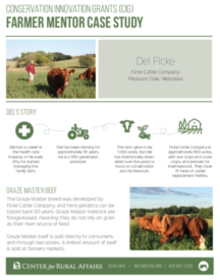- Del had a career in the health care industry. In his early 20s, he started managing the family farm.
- Del has been farming for approximately 30 years. He is a fifth generation producer.
- The farm grew to be 7,000 acres, but Del has intentionally downsized over the years to focus on conservation and his livestock.
- Ficke Cattle Company is approximately 600 acres, with row crops and cover crops, and pasture for their livestock. They have 70 head of cattle/replacement heifers.
Graze Master Beef
The Graze Master breed was developed by Ficke Cattle Company, and herd genetics can be traced back 50 years. Graze Master livestock are forage-based, meaning they do not rely on grain as their main source of feed.
Graze Master beef is sold directly to consumers, and through two stores. A limited amount of beef is sold at farmers markets.
On conservation
"If every farmer made a 10 percent change, the landscape would greatly improve. Small changes yield big results. Current conversation programs could be improved by utilizing a more holistic approach and by finding balance."
Conservation practices used
No-till and cover crops for more than 30 years.
Intensive grazing and a pollinator habitat.
Crop insurance
"Crop insurance should be tied to soil quality, which would be one way to incentivize conservation. We should focus onbuilding organic matter and restoring biodiversity in our soil."
Sustainable agriculture
"My generation is of no consequence. If the way we farm isn’t changed in the next decade, we’re out of time"
Getting into agriculture
“There’s never been more opportunity to get into agriculture. We’re revisiting all the things that we did 100 years ago... and know that farming takes hard work. It doesn’t come easy.”
Read more about Del Ficke on our blog by clicking here.
This material is based upon work supported by the Natural Resources Conservation Service, U.S. Department of Agriculture, under number 69-3A75-17-46. Any opinions, findings, conclusions, or recommendations expressed in this publication are those of the author(s) and do not necessarily reflect the views of the USDA. USDA is an equal opportunity provider and employer.


